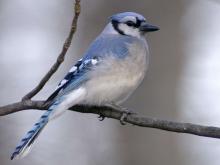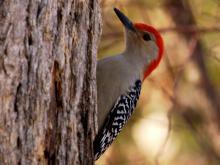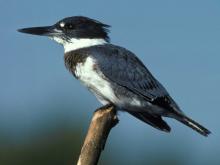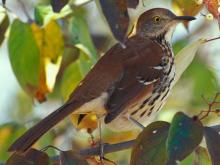Birds
Media

Species Types
Scientific Name
Cyanocitta cristata
Description
Blue jays are notable for their loud voices, blue and white plumage, strong black bill, relatively large size and the distinctive crest atop their heads.
Media

Species Types
Scientific Name
Podiceps auritus
Description
Horned grebes are small ducklike birds that may be seen in Missouri during migration and locally in the winter. Breeding coloration is different from that of winter.
Media

Species Types
Scientific Name
Sternula antillarum
Description
The least tern is gull-like, gray above and white below. The head has a black cap and nape, and a white forehead. The bill is bright yellow and its sharp tip is black. The tail is deeply forked. Look for it along big rivers April–September.
Media

Species Types
Scientific Name
Melanerpes erythrocephalus
Description
A flurry of black-and-white wingbeats and a bright, all-red head announce the presence of the red-headed woodpecker. The voice is a loud, descending “kweeer.”
Media

Species Types
Scientific Name
Melanerpes carolinus
Description
A striking woodpecker with grayish white face and underparts, black-and-white banded upperparts, and a red band on the head or nape. The red belly is often not noticeable.
Media

Species Types
Scientific Name
Pluvialis dominica
Description
The American golden-plover is a robin-sized shorebird that makes an incredible annual odyssey from Argentina to the Arctic tundra, a distance of over 20,000 miles. It flies through Missouri in spring.
Media

Species Types
Scientific Name
Columba livia
Description
This is the common pigeon of city parks, downtown buildings, barns, and cliffs. Many color forms exist. The wild type has a dark head, breast, and shoulders, a light gray body, two dark bars on the wings, a white rump, and a dark band on the tip of the tail.
Media

Species Types
Scientific Name
Megaceryle alcyon (formerly Ceryle alcyon)
Description
Belted kingfishers have a big head with a shaggy crest, a long, sharp bill, and a short tail. They perch or hover along rivers and shores, then plunge in to catch fish. The call is a loud rattle.
Media

Species Types
Scientific Name
Streptopelia decaocto
Description
The Eurasian collared-dove was introduced in the Bahamas and has rapidly spread throughout most of the United States. At first glance, it looks like a chunky, pale gray mourning dove.
Media

Species Types
Scientific Name
Toxostoma rufum
Description
The brown thrasher, named for the busy thrashes of its long tail, is closely related to the mockingbird and catbird. Like them, it mimics songs of other birds. It’s common in parks and yards.
See Also







Media

Species Types
Scientific Name
Hemaris diffinis
Description
The snowberry clearwing is a moth that confuses people because it looks like a bumblebee and flies like a hummingbird!
Media

Species Types
Scientific Name
Hyles lineata
Description
The white-lined sphinx moth sometimes confuses people because it flies, hovers, and eats from flowers like a hummingbird. The adults often fly during daylight hours as well as in the night and are often found at lights.
Media

Species Types
Scientific Name
Darapsa myron
Description
The Virginia creeper sphinx moth is common in woods and brushy areas and comes to lights at night. The larvae eat Virginia creeper and grape leaves.
Media

Species Types
Scientific Name
Perimyotis subflavus (formerly Pipistrellus subflavus)
Description
Tri-colored bats, formerly called eastern pipistrelles, are relatively small and look pale yellowish or pale reddish brown. The main hairs are dark gray at the base, broadly banded with yellowish brown, and tipped with dark brown.
Media

Species Types
Scientific Name
Myotis grisescens
Description
Gray myotises are difficult to distinguish from other mouse-eared bats. A key identifying feature of the gray myotis is that its wing is attached to the ankle and not at the base of the toes. It’s an endangered species.
Media

Species Types
Scientific Name
Myotis lucifugus
Description
The little brown myotis (little brown bat) is one of our most common bats, but populations are declining. White-nose syndrome has taken a heavy toll in northeastern states. This species is now listed as vulnerable across its range.
Media

Species Types
Scientific Name
Myotis sodalis
Description
The Indiana myotis, or Indiana bat, summers along streams and rivers in north Missouri, raising its young under the bark of certain trees. It is an endangered species.
About Birds in Missouri
About 350 species of birds are likely to be seen in Missouri, though nearly 400 have been recorded within our borders. Most people know a bird when they see one — it has feathers, wings, and a bill. Birds are warm-blooded, and most species can fly. Many migrate hundreds or thousands of miles. Birds lay hard-shelled eggs (often in a nest), and the parents care for the young. Many communicate with songs and calls.





















